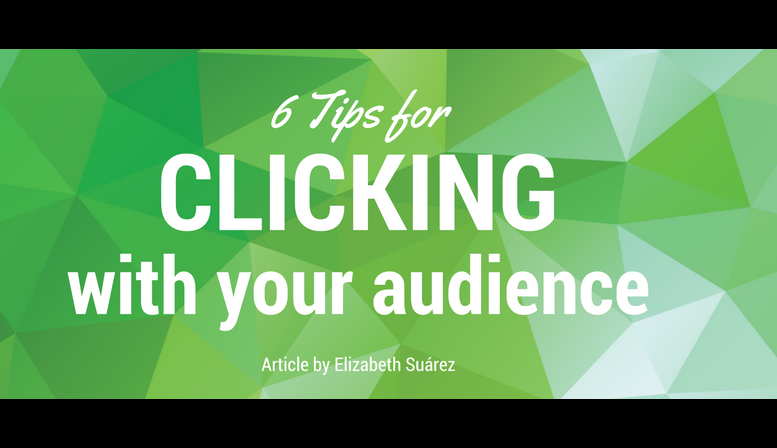6 Tips for clicking with your audience

At the conclusion of a recent speaking engagement an audience member stated:
“I was surprised you kept me engaged the entire time.”
At first, I viewed the comment as a compliment.
But once I left the venue I started wondering if most audience members could say that about my speech. As a trained engineer, I take any piece of data to heart, by trying to figure out what a statement means.
After investing some time thinking about my experience as a speaker as well as an audience member, it was evident how some speakers commanded a standing-room-only crowd; others struggled to fill the front row of seats, no matter the topic. One of the most engaging speakers I have seen covered driest-sounding topics (Quantum Physics, anyone?).
As an inquisitive engineer, I set out to determine the secrets that allowed some speakers to click with their audiences.
I’ve refined these tips over the years, and present to you my 6 tips for becoming an effective speaker.
1. Perfect your topic(s)
Don't try to be everything for everybody.
Focus on one or two subject areas related to your experience, which you can develop into keynotes and other forms of speaking.
When you present, make sure to use good principles of storytelling, including an impactful beginning, a building of conflict, a climactic middle, and a satisfying resolution.

2. Use visuals to enliven the presentation
If you opt to use a visual presentation, don't fill it up excessively with writing.
The audience wants to watch you present, not read a wall of text.

Instead, focus on visual content, such as photos, videos, and colorful graphics. Add explanatory text only when needed, and keep it short.
Tasteful use of text and simple photo animations is fine, but don’t go overboard.
Using too many animations will tire your audience and distract from the message of your presentation.
3. Make it interactive
Get the audience involved from the start.
Take advantage of the fact that everyone carries a smartphone these days and use live polling apps.
Your audience will enjoy the interactivity, and will appreciate the fact that you are customizing your presentation based on their live input.
4. Know your audience and customize your message
Inquire ahead of time as to some of the challenges your audience is currently facing, then customize your speech to address their issues or concerns.
Your audience is looking for solutions to their problems, so don’t focus too heavily on yourself, or remain anchored in the theoretical.
Instead, make your speech relatable by introducing one or two issues that audience members might be dealing with on a daily basis.

Be a storyteller as you share solutions to their problems.
The audience will feel the information you are sharing is worthy of their attention, which will keep them engaged throughout the presentation.
5. Share one-liners via social media to enhance engagement
One-liners have become the new “elevator speech.”
Develop one-liners you can tweet about before and after your speech.
Use them throughout your speech, which will encourage your audience to share them on social media.
There is no better way to make a difference than having others tweet about your content.
Speakers often become so involved in their presentation that they forget to keep their message simple and understandable. Think short and sweet sentences.

6. Channel your nervous energy
Any professional speaker will admit that it can be nerve racking to get in front of an audience.
However, speakers live for that adrenaline. I always recommend taking some time prior to your talk to reflect on why you became a speaker and in what ways you seek to influence your audience.
Next time you book a speaking engagement take some time to assess your tool box. Is your presentation truly interactive? Do you have a few catchy one-liners people can tweet about? Were you able to have a presentation dry-run with individuals who could represent the audience you are about to address? And last but not least, are you pumped and excited to speak? Having energy and showing passion is half the battle. As you are speaking, reflect on those answers and enjoy the ride.

A bit about the author
Elizabeth is highly regarded as an author, speaker, and strategic facilitator. Best Seller Amazon author of “The Art of Getting Everything.” Elizabeth is passionate about helping professionals better understand how to manage disagreements, succeed in any negotiation and develop the strategies and tactics for success, while deploying ethical persuasion and inclusiveness skills.
Elizabeth is an entertaining, motivating, and provocative speaker who educates and inspires audiences with her unique interactive style and humorous approach.
Links
- Elizabeth Suárez’s SpeakerHub Profile
- The Results Strategist official website
- The Art of Getting Everything: How to Negotiate for What You Want and More









